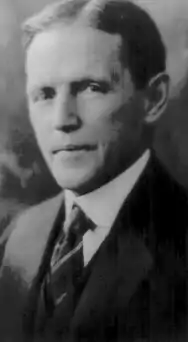William Bates (physician)
William Horatio Bates (December 23, 1860 – July 10, 1931) was an American physician who practiced ophthalmology and developed what became known as the Bates method for better eyesight. The method was based in his theory that the eye does not focus by changing the power of the lens, but rather by elongating the eyeball through use of the extraocular oblique muscles; this model contradicted mainstream ophthalmology and optometry then and now.[1][2]
William Bates | |
|---|---|
 | |
| Born | December 23, 1860 Newark, New Jersey, United States |
| Died | July 10, 1931 (aged 70) New York City, New York, United States |
| Nationality | American |
| Alma mater | Columbia University |
| Known for | Developing the Bates method |
| Scientific career | |
| Fields | Ophthalmology |
Biography
Bates graduated A.B. from Cornell University in 1881 and received his medical degree at Columbia University's College of Physicians and Surgeons in 1885. He formulated a theory about vision health, and published the book Perfect Sight Without Glasses in 1920, and the magazine Better Eyesight from 1919 to 1930. Parts of Bates' approach to correcting vision disorders were based on psychological principles, which were contrary to many of the medical theories of the time and remain so. The Bates method still enjoys some limited acceptance as a modality of alternative medicine.
Bates treated many patients, who claimed to have been cured of vision defects, especially myopia. This brought him into conflict with his peers. He defended himself by claiming that other physicians were in thrall to the establishment.
Bates' publications
Because the copyrights have expired, the original version of Perfect Sight Without Glasses (or The Cure of Imperfect Sight by Treatment Without Glasses) is now in the public domain. In 1943, an abridged version was published under the title Better Eyesight Without Glasses, which removed some of the most controversial points, such as the claim that "perfectly remembering black"[3] is a suitable substitute for anaesthesia, and recommendations to look at the sun.[1]
Disappearance
In 1902, Bates disappeared from New York, and was reportedly located at Charing Cross Hospital in London with apparent amnesia. After being found by his wife, Bates disappeared again, later turning up in North Dakota.[4]
Personal life
Bates was married three times. After being widowed twice, he married Emily C. Lierman, his long-time personal assistant.
Discovery of the medical use of adrenaline
Bates did other research. He discovered the astringent and haemostatic properties of the substance produced by the adrenal glands, and its value in medicine, especially in surgeries. The substance was later commercialized as adrenaline.[5]
See also
References
- Marg, E. (1952). ""Flashes" of clear vision and negative accommodation with reference to the Bates Method of visual training" (PDF). Am J Opt Arch Am AC Opt. 29 (4): 167–84. doi:10.1097/00006324-195204000-00001. PMID 14923801. Archived from the original (PDF) on 2008-05-29.
- Russell S. Worrall OD; Jacob Nevyas; Stephen Barrett MD (6 July 2018). "Eye-Related Quackery". Quackwatch. Retrieved 2020-05-31.
- Wikisource:Perfect Sight Without Glasses/Chapter 19
- "Obituary of William H. Bates". New York Times. July 11, 1931.
- Bates, William H. (1896). "The Use of Extract of Suprarenal Capsule in the Eye". New York Medical Journal. pp. 647–650.
External links
- Nate Pedersen (8 March 2018). "The Mysterious Disappearance—and Strange Reappearance—of Dr. William Horatio Bates". Mental Floss.
| Wikisource has original works written by or about: William Bates |